
The logo in honor of the extraordinary jubilee year of mercy, designed by Father Marko Rupnik, S.J., is in the style of an icon. This means that all of its elements symbolize something. Learning about the significance of these various parts can deepen our understanding of this year established, “in hopes that a new flood of mercy will flow over the world.” In case you aren’t aware of the meaning of icon features—and if you haven’t been introduced to the mercy logo already,—here is some information. The two figures stand for Christ, who has the halo, and “Adam” or humanity…us. Christ carries the person over his shoulders the way a shepherd carries a sheep. This obviously refers to the Good Shepherd, Jesus who rescued the human race that had gone astray. The Divine Shepherd laid down his life for his sheep. The black slats Jesus stands on in the logo remind us of the cross. The wounds in his hands and feet are scars from his redeeming sacrifice. The redemption of the world is the greatest act of mercy God ever performed.
Some people interpret Jesus carrying the man to stand for the Good Samaritan. Just as the Samaritan went out of his way to care for the man robbed and beaten and left at the side of the road, Jesus took care of us after we were attacked by Satan.
A strange thing about the two persons is that they share one eye. This indicates that Christ communicates himself to us and so now we can see things as God sees them. This is the definition of wisdom: seeing things as God sees them. The man’s mouth is very close to Christ’s. It’s been said that as Christ expired on the cross, human beings inhaled his breath and obtained new life. This echoes creation, when God breathed into man and he became a living being.
The mercy icon is almond shaped for several reasons. The almond shape is standard in iconography and used around Christ and later Mary and the saints. It is called a mandorla, which is from the Italian for “almond.” When two circles overlap, the part where they merge has the shape of an almond. This represents the divine nature and the human nature that are merged in Christ. An almond tree blooms early and is therefore a sign of life, of new beginnings. Thanks to God’s mercy, we have a second chance to live with him in bliss forever. The painter Van Gogh painted almond branches to honor the birth of his nephew and gave this masterpiece to his brother. In Hebrew the name for almond means “watching.” We, the redeemed who live in the last age, are watching for the next coming of Christ.
One of my favorite poems is by Nikos Kazantzakis:
I said to the almond tree,
“Sister, speak to me of God,”
and the almond tree blossomed.
The three blue concentric almond shapes range from light on the outside to dark. This can stand for the spiritual journey to God, in which we are led to the “dark night” where we experience God in unfathomable mystery. On the other hand, the blue shapes can be seen as going from dark on the inside to light, symbolic of Christ’s leading us out of the darkness of sin and death and into eternal light.
Speaking of the color blue, colors in icons have specific meanings. Blue stands for humanity; red for blood, life, and divinity; and white for the light of Christ. Gold, naturally, is a color for divinity. Notice in the mercy icon, the man wears a gold robe. Because of Christ, we are able to be like God.
The words on the icon, “Merciful like the Father,” are from Luke 6:36. (Luke’s Gospel is called the Gospel of Mercy.) Jesus tells us that we are to be merciful as the Father is merciful, which is the motto for this special jubilee year. But in the context of the icon, the words can mean that Jesus is merciful like the Father.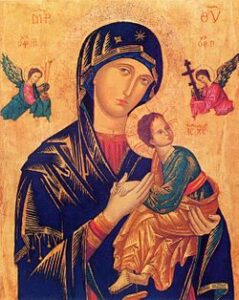 He is the face of God’s mercy.
He is the face of God’s mercy.
If this has whetted your appetite for studying more icons. I recommend the icon of Our Lady of Perpetual Help. It is a visual representation of Mary, the Mother of Mercies. We can run to her for help like Jesus does in the picture at the vision of his future execution: so fast that his sandal falls off. He grasps his mother’s hand for comfort and safety.
What work of mercy have you performed recently? What do you plan to do?
Below is a recording of the Year of Mercy hymn with English verses.

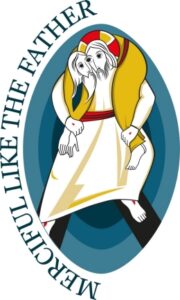

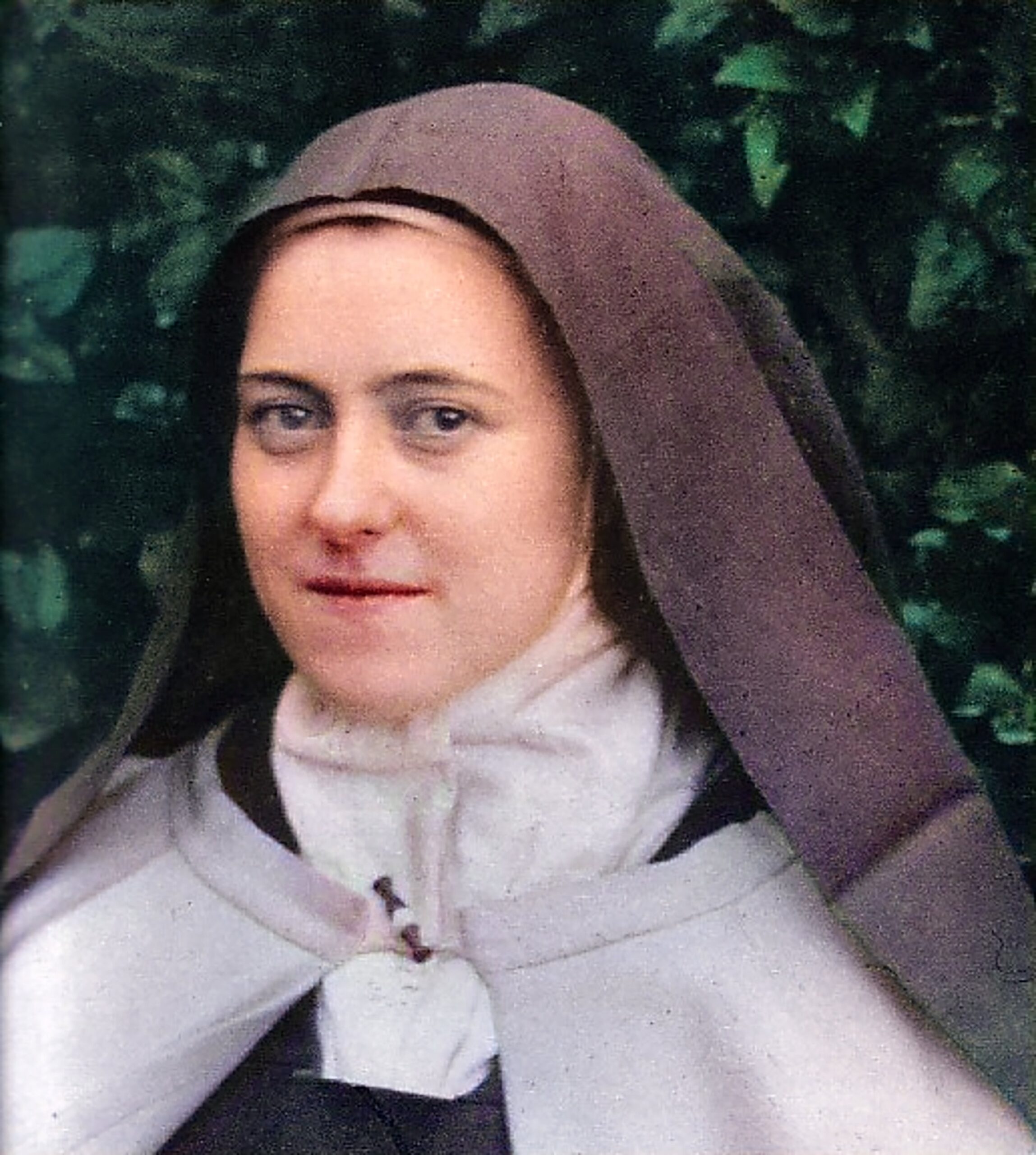



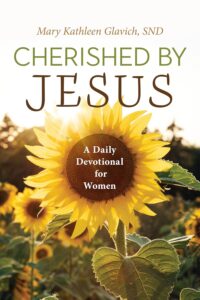
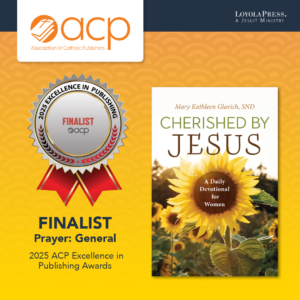
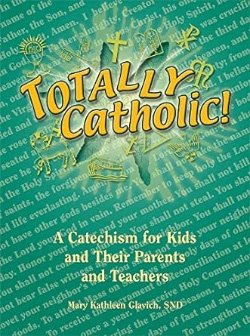


4 Responses
Thank you! This is a beautiful explanation of the logo, which I had never seen before–or perhaps just did not pay attention to.
I saw this logo, but didn’t know the depths of meaning it held until I prepared to give a retreat on this year of mercy!
Hey Sister,
A couple of thinks before I answer your question.
First, I find it interesting that you chose Van Gogh’s almond branches as the painting to compare with Father Rupnik’s design. In my opinion, Van Gogh painted with extreme emotion, almost like he was striking out with each brush stroke. This is why I love his paintings, not only do I appreciate the art, but I also appreciate the artist. I can almost see him painting.
The jubilee year of mercy logo has the opposite result. When I look at the logo, it calms me down. The smoothness of the lines. The warmth of the colors. The looks on the faces.
Second, I absolutely love the poem you chose. So simple, so perfect. I read it and I actually imagined God doing that. What a beautiful way to speak without words.
As for acts of mercy, well, I’m here in Boston getting ready to do the marathon on Monday with my wife, Linda. To make a long story short, I’m going to be helping Linda run 26.2 miles. I’ll carry her over the finish line if I have to, though not like the logo.
Mark
Thanks for your interesting comments as always, Mark. Your last paragraph made me laugh out loud. Did Linda run all that way? I doubt that I could run half of one mile!
I was in Boston myself the week before last. And last week I spent in sunny Florida.
Coincidentally the first book I wrote was all about God’s “beautiful way to speak without words.” It was called “Voices: Messages in Gospel Symbols.” I opened with that poem about the almond tree and cited Psalm 19:1–4. I also quoted a hymn by St. Gregory Nazianzus: “All things proclaim you—things that can speak, things that can not. . . .
All things breathe you a prayer/ a silent hymn of your own composing.”
In the book are reflections on inanimate things in the Gospel like gold, wine, nets, fringe. It’s out of print except for some copies I have. Maybe I’ll update it someday.